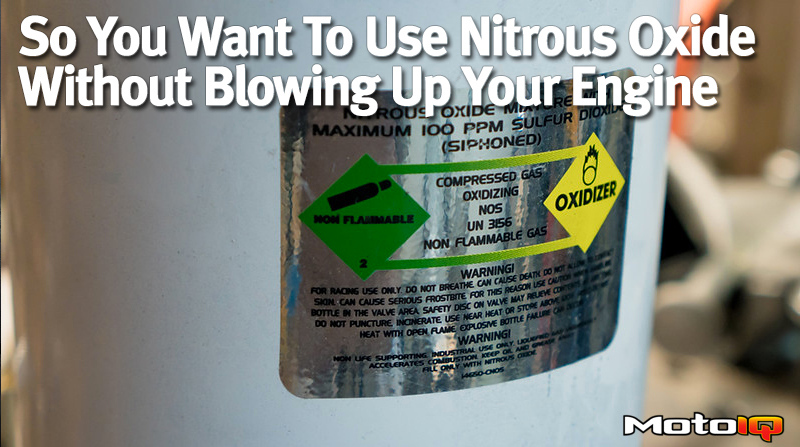
So You Want To Use Nitrous Oxide Without Blowing Up Your Engine
Nitrous oxide has a bad rap, and the reason it has a bad rap is the same reason it is so great: it’s easy. Too easy; for about $500 and a few hours of work, you can add basically any amount of power you want. If you are a reasonable person with self-control and a nitrous controller, you can add 35 horsepower to your Ford Mustang and be totally content. This is, of course, a fictional situation because nobody who drives a Mustang has that kind of self-control. In fact, most gearheads don’t think this way. I know this because when I added 25 horsepower to my engine, literally all of my friends had the same question: “Why only 25?”
Because I don’t want to scatter a trail of oil and connecting rod pieces down the pavement like some sort of junkyard Johnny Appleseed. Because I sat down, looked in the mirror, and said, “Twenty-five is enough. I am not going to succumb to the almost overwhelming urge to go with just a little bit bigger jet size.”
Later, of course, I installed the 35 horsepower jets, proud of myself that I resisted the urge to go all the way to 50.
This lack of self-control is a common reason why nitrous oxide gets the unfair reputation. Also to blame: installations that result in an improper oxygen/fuel mixture, and too much nitrous oxide at the wrong RPM. How to avoid these failures? Use a wet system, install a nitrous controller, and don’t go overboard with the added power.
Wet Systems
 Two solenoids: one for nitrous, one for fuel. This is the correct number of solenoids. Also acceptable is 4, 6, or 8. Never 1.
Two solenoids: one for nitrous, one for fuel. This is the correct number of solenoids. Also acceptable is 4, 6, or 8. Never 1.Wet systems add extra fuel with the oxygen in the appropriate ratio (assuming you set up the jets correctly). This is the same as you saying “Here you go engine; here’s 50 extra horsepower in a neat little package.”
The kit (or the internet) should tell you what combination of jets to use for the desired power, but you should use a wideband oxygen sensor to verify that the jets are giving you the air/fuel ratio you are looking for. Generally, you want to have the same ratio with nitrous oxide as you have without.
If you are running a fuel injection system, it may automatically fix your slightly incorrect jet pairing. It will also add more fuel to compensate for the colder air; part of the power increase from nitrous oxide comes from the colder, denser air you get when nitrous oxide changes from a liquid to a gas. This phenomenon was the inspiration for the hit 70's funk band “Latent Heat, And The Vaporizations.”
Okay, that last sentence is not true.
Nitrous controller
The next key to not exploding your shit is a nitrous controller. A controller will look at your RPMs, your throttle position, and hopefully your fuel pressure, and will only activate the nitrous oxide when these parameters line up in the don’t-explode-the-engine column. They also do other things, depending on how much money you spend, like measure nitrous pressure, boost, and vehicle speed, and progressively add nitrous oxide instead of just dumping max horsepower at once. (If you’re thinking about using a multi-stage system, you might be better off getting a fancy controller that will pulse width modulate the solenoids and give you a much better ramp in; the controllers these days are pretty great.) You may not need some of these features, but you definitely need something that will keep the solenoids from opening when you’re at low RPMs, are not at full throttle, or don’t have fuel pressure.
 You can actually accomplish the basics without a nitrous controller if you use an RPM window switch and have dummy switches for wide open throttle and fuel pressure wired in series.
You can actually accomplish the basics without a nitrous controller if you use an RPM window switch and have dummy switches for wide open throttle and fuel pressure wired in series.It is important to measure fuel pressure because you’ll go super lean if you keep spraying nitrous oxide when fuel flow decreases. This could happen if you’re low on fuel and it sloshes away from the pickup, or if you tied your wet system into your existing fuel pump and you’ve just reached the flow limit of that system.




6 comments
Does anyone sell a complete system, the pressure gages,controller., and the device to prevent nitros dump at too low rpm ? I mean all the parts in one kit.
You can set up control parameters not to do that.
Can you put a small amount of oxygen in before your carbie and add more fuel to it at the same time.
Not recommended.
I am thinking about buying a car with an already installed NOS system. Any tips?
I am considering buying a car that has a NOS system. It is a 2003 acura cl. Is this a good car to buy or am I better off with something like a Del Sol civic? I am also considering a 2005 mazda rx-8 but I dont know the reliability of the vehicle and wanted to get the opinion of fellow gearheads.